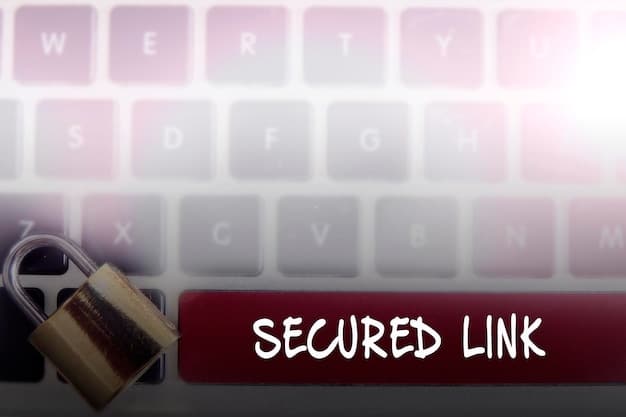Secure Zoom Meetings: A Step-by-Step Guide Against Uninvited Guests

Securing your Zoom meetings from uninvited guests requires proactive implementation of critical security features and best practices to ensure privacy and prevent disruptions.
In an increasingly connected world, remote collaboration tools like Zoom have become indispensable. However, convenience often comes with security considerations, especially after numerous reports of “Zoom-bombing” – the unwelcome intrusion of uninvited guests into virtual meetings. Learning how to secure your Zoom meetings from uninvited guests: a step-by-step guide, is no longer optional but a fundamental requirement for anyone utilizing the platform for personal, professional, or educational purposes. This comprehensive guide aims to equip you with the knowledge and actionable steps needed to safeguard your virtual spaces, ensuring productive and private interactions.
Understanding the Threat: Who Are These Uninvited Guests?
Before diving into prevention, it’s crucial to understand the nature of the threat. Uninvited guests, often referred to as “Zoom-bombers,” are individuals who gain unauthorized access to a Zoom meeting. Their motives vary widely, ranging from simple pranks and disruptive behavior to malicious intent, such as sharing inappropriate content, harassing participants, or even stealing sensitive information. These intrusions can severely compromise the integrity and privacy of a meeting, causing distress and operational downtime.
The methods used by these intruders often exploit publicly available meeting links, weak password practices, or the lack of proper security configurations within Zoom itself. Understanding these common vectors of attack is the first step towards building a robust defense. Without a clear picture of how these incursions happen, any security measures implemented might be incomplete or ineffective. This foundational understanding helps in prioritizing which security features to enable and enforce for every meeting.
Common Tactics Employed by Zoom-Bombers
Zoom-bombers are resourceful, constantly adapting their methods to bypass security measures. Awareness of these tactics is vital for hosts and participants alike:
- Publicly Shared Links: Meeting links posted on social media, public calendars, or unchecked websites are prime targets.
- Guessing Meeting IDs: While less common now, some intruders attempt to guess meeting IDs, especially for meetings without passwords.
- Exploiting Weak Passwords: Easy-to-guess passwords or default passwords can be cracked quickly, providing direct access.
- Lack of Waiting Rooms: Without a waiting room, anyone with the link can join directly without host approval.
Each of these tactics highlights a vulnerability that, if left unaddressed, can become a gateway for unwanted guests. It’s not just about what Zoom offers, but how conscientiously those features are applied by the user. A strong defense strategy integrates multiple layers of protection, making it increasingly difficult for intruders to find an entry point.
The Impact of Uninvited Intrusions
The consequences of a Zoom-bombing incident can be far-reaching. Beyond the immediate disruption and embarrassment, there are tangible impacts on productivity, privacy, and even psychological well-being. For businesses, proprietary information might be exposed. For educational institutions, learning environments can be severely compromised. Personal conversations can be invaded, leading to a breach of privacy that might have legal or reputational repercussions.
Recognizing the severity of these impacts underscores the urgency of implementing strong security protocols. It’s not just about preventing a nuisance, but protecting the continuity of operations, the confidentiality of information, and the safety of all participants. A holistic approach that educates users and enforces strict security disciplines is paramount to mitigating these risks effectively.
Pre-Meeting Preparations: Setting the Stage for Security
The most effective security measures begin before your meeting even starts. Proactive configuration plays a significant role in deterring uninvited guests. By carefully adjusting settings within your Zoom account and for individual meetings, you can dramatically reduce the risk of intrusion. This step-by-step preparation ensures that your virtual door is locked and guarded even before the first participant arrives, creating a secure environment from the outset.
It involves a strategic review of default settings, understanding their implications, and customizing them to suit the specific needs and sensitivity of each meeting. Ignoring these pre-meeting configurations is akin to leaving your front door wide open when expecting important guests; it invites trouble. Every minute spent on proper setup saves hours of potential disruption and recovery later.
Mandatory Security Settings for Your Account
Before scheduling any meeting, visit your Zoom account settings. These global settings provide a baseline level of security for all your future meetings:
- Require a Passcode for All Meetings: This is fundamental. Ensure that a passcode is automatically generated or custom-set for every meeting you host.
- Enable Waiting Room: The Waiting Room feature places participants in a virtual holding area until you admit them. This allows you to vet attendees before they join the main session.
- Disable “Join Before Host”: This prevents participants from entering the meeting space before you, the host, have arrived and potentially secured the environment.
Implementing these three measures alone can significantly escalate your meeting’s security posture. They act as critical checkpoints, forcing any potential intruder to overcome multiple barriers. It is a simple yet powerful way to ensure that only intended participants enter your virtual space, establishing immediate control over access.
Meeting-Specific Security Options
Beyond account-level settings, you have granular control over individual meetings:
- Generate Unique Meeting IDs: Avoid using your Personal Meeting ID (PMI) for public or sensitive meetings, as it is static and can be compromised. Always generate a unique ID for each new meeting.
- Edit Participant Options: When scheduling, look for options to mute participants upon entry, restrict screen sharing to the host only, and disable chat for certain types of meetings if necessary.
- Set Up Alternative Hosts: For larger meetings, having a co-host can help manage participants and security features, especially if the primary host gets disconnected or needs assistance.
These specific adjustments allow for tailored security, adapting to the nuances of each meeting. A casual family check-in might not require the same stringent settings as a confidential business presentation. Customizing these options ensures that you’re not over-securing when unnecessary, nor under-securing when vital. This flexibility is key to practical and effective security.

During the Meeting: Real-Time Security Management
Even with robust pre-meeting preparations, real-time vigilance is essential. Once your Zoom meeting is underway, the host retains significant power to manage participants and react to any suspicious activity. This active management phase is where you apply and enforce the security measures you’ve thoughtfully put in place. Being aware of and utilizing these in-meeting controls is critical for maintaining a secure and productive environment, especially when unexpected challenges arise.
The ability to respond swiftly to potential threats separates a secure meeting from a vulnerable one. This includes monitoring participant behavior, recognizing warning signs, and knowing exactly which tools to deploy at a moment’s notice. Proactive hosting during the meeting itself reinforces the layers of security established beforehand, ensuring that your virtual space remains under your control.
Key In-Meeting Security Controls
Zoom offers a “Security” icon in the meeting toolbar (for hosts), which consolidates several critical features:
- Lock Meeting: Once all expected participants have joined, you can click “Lock Meeting.” This prevents anyone else from joining, even if they have the meeting ID and passcode.
- Remove Participant: If an uninvited guest or disruptive individual somehow bypasses your defenses, you can click on their name in the participant list and select “Remove.” They will be disconnected from the meeting and cannot rejoin unless you allow them.
- Suspend Participant Activities: This powerful feature allows the host to temporarily pause all participant activities, including video, audio, screen sharing, and chat. This is ideal for quickly stopping a “Zoom-bombing” in progress.
These controls are your arsenal during the live meeting. Learning where they are and how to use them efficiently can mean the difference between a minor blip and a complete derailment. Familiarity with these features ensures that you can respond confidently and effectively to any security challenge that may arise, keeping your meeting on track and secure.
Managing Participant Behavior and Permissions
Beyond the core security controls, hosts can dynamically manage participant permissions:
- Mute All Participants: This is invaluable for large meetings or when an individual’s microphone causes feedback or disruption. You can also prevent participants from unmuting themselves.
- Disable Participant Screen Sharing: By default, ensure only the host can share their screen. This prevents uninvited guests from sharing inappropriate content. If a participant needs to share, you can grant them permission temporarily.
- Disable Chat: For certain very sensitive meetings, or if chat becomes a distraction or avenue for disruption, you can disable it entirely or restrict it to direct messages to the host.
These fine-grained controls empower the host to maintain order and focus. By actively managing these permissions, you can create an environment that minimizes opportunities for disruption and maximizes attendee engagement. It’s about proactive moderation, not just reactive damage control, ensuring a smoother and more secure meeting experience for everyone involved.
Post-Meeting Protocols: Enhancing Future Security
Security doesn’t end when the meeting concludes. Reviewing post-meeting activities and implementing certain protocols can provide valuable insights for future improvements and further strengthen your security posture. This reflective phase helps in identifying what worked well, what didn’t, and how you can continuously adapt your strategies against evolving threats. It transforms each meeting into a learning opportunity, building a more resilient system over time.
The information gathered post-meeting—feedback from participants, logs of activities, or incidents that occurred—is crucial for refining your approach. It’s about closing the loop on the security cycle, ensuring that every experience contributes to a safer virtual environment for all subsequent interactions. This continuous improvement mindset is key to staying ahead of potential vulnerabilities.
Reviewing Meeting Reports and Logs
Zoom provides various reports and logs that can be invaluable for post-incident analysis and general security assessment:
- Participant Reports: Review who attended and for how long. This can help identify any unauthorized entries or suspicious activity.
- In-Meeting Chat Logs: If chat was enabled, reviewing logs can reveal any inappropriate messages or attempts at harassment that might have been missed in real-time.
- Recording Transcripts: For recorded meetings, transcripts can provide a written record of discussions, helping pinpoint any disruptive audio intrusions.
Analyzing these reports helps in identifying patterns of intrusion or common vulnerabilities. Perhaps a specific meeting ID was unintentionally shared too widely, or a participant’s behavior suggests a need for a more stringent vetting process in the future. This data-driven approach leads to more targeted and effective security enhancements.
Updating Practices and Educating Users
Based on your post-meeting analysis, it’s essential to update your security practices and, crucially, to educate your participants:
- Refine Default Settings: If a particular vulnerability was exploited, adjust your default Zoom account settings to mitigate that risk for all future meetings.
- Share Best Practices with Participants: Educate your attendees on their role in security, such as not sharing meeting links publicly and reporting suspicious activity.
- Regularly Review Zoom Security Updates: Zoom frequently releases updates and new security features. Staying informed and applying these updates is critical.
Security is a shared responsibility. While hosts bear the primary burden, informed participants are an invaluable asset in maintaining a secure environment. Continuous education ensures that everyone is playing their part, contributing to a collective defense mechanism against uninvited guests. This collaborative effort makes the entire virtual community safer and more resilient.
Advanced Security Measures for High-Stakes Meetings
While standard security practices cover most scenarios, certain high-stakes or highly confidential meetings demand an extra layer of protection. These could include board meetings, sensitive client discussions, or classes involving minors. For these situations, adopting advanced security measures beyond the basic recommendations is not just advisable but often imperative. These enhanced protocols create a nearly impenetrable barrier, safeguarding your most critical virtual interactions from any form of unauthorized access or disruption.
The investment in these advanced measures translates directly into peace of mind and the assurance that sensitive information and crucial discussions remain private. It’s about leveraging Zoom’s full suite of security functionalities and integrating external best practices to build a fortress around your virtual space, ensuring the highest level of confidentiality and control.
End-to-End Encryption and Authentication
For ultimate privacy, consider these advanced settings:
- End-to-End Encryption (E2EE): Enable E2EE for meetings where the highest level of privacy is required. This ensures that only participants communicate and read messages, preventing even Zoom from accessing the content. Note that E2EE has some feature limitations (e.g., cloud recording, live transcription are unavailable).
- Authentication Profiles: Restrict meeting access to only authenticated Zoom users or users from a specific domain. This means participants must be logged into a verified Zoom account, potentially linked to your organization’s directory, ensuring only known individuals can join.
These measures add significant hurdles for any malicious actor. E2EE ensures the content of your communication is secure from interception, while authentication profiles guarantee that only legitimate, verified individuals can even attempt to join. Together, they form a formidable barrier, making your high-stakes meetings virtually impervious to external threats.
Utilizing Webinar Features and Controlled Environments
For large events or public presentations where interaction needs to be tightly controlled, Zoom Webinar is a superior alternative to basic meetings:
- Webinar Mode: In a Zoom Webinar, only panelists and the host can turn on their video and audio. Attendees are typically view-only and can interact via Q&A and chat, but cannot disrupt the main presentation. This significantly reduces the risk of “Zoom-bombing.”
- Registration Requirements: Force all attendees to register for the meeting or webinar. This allows you to collect information, vet participants beforehand, and send unique, personalized joining links, making it harder for uninvited guests to slip through.
While often associated with larger public events, these features provide a controlled environment that is inherently more secure for many high-stakes situations. They shift the dynamic from an open collaborative space to a more structured broadcast, which can be precisely what’s needed for sensitive one-to-many communication, ensuring that only designated speakers can influence the proceedings.
Educating Participants: The Human Element of Security
No matter how many technical safeguards you implement, human error remains a significant vulnerability. Educating your participants about security best practices is as crucial as configuring the settings themselves. An informed participant base acts as an additional layer of defense, capable of recognizing suspicious activity and adhering to security protocols. This collaborative approach to security acknowledges that everyone involved has a role to play in maintaining a safe virtual environment.
The goal is to foster a culture of security awareness, where participants understand the ‘why’ behind certain rules, rather than just the ‘what.’ Clear communication and user-friendly guidelines can transform potential vulnerabilities into proactive allies, significantly bolstering your overall security posture and ensuring a smooth, secure meeting experience for everyone.
Best Practices for Meeting Attendees
Provide clear instructions and expectations for your participants before and during the meeting:
- Do Not Share Meeting Links Publicly: Emphasize the importance of keeping meeting links private and only sharing them with authorized participants.
- Use Renaming Appropriately: Advise participants to use their real names or a designated format (e.g., “Full Name – Organization”) so hosts can easily identify them.
- Report Suspicious Activity: Encourage participants to immediately report any unusual or disruptive behavior directly to the host via private chat or other designated channels.
These simple guidelines empower participants to be active contributors to meeting security. When everyone understands their role and the potential risks, the collective vigilance significantly decreases the likelihood of a successful intrusion. It is about transforming passive attendees into active guardians of the shared virtual space.
Creating a Shared Responsibility Mindset
Promote a sense of shared responsibility for meeting security:
- Pre-Meeting Reminders: Include a brief security reminder in your meeting invitations, highlighting key rules for participation.
- During-Meeting Etiquette: Briefly reiterate security expectations at the start of the meeting, especially for new groups or highly sensitive discussions.
- Post-Meeting Feedback: Create channels for participants to provide feedback on security, helping identify areas for improvement and reinforcing their involvement.
By making security a collective effort, you reduce the burden on the host and create a more resilient virtual environment. When participants feel invested in the security of the meeting, they are more likely to follow protocols, report concerns, and contribute to a safe and productive experience for all. This human, collaborative element is ultimately the most powerful defense against uninvited guests.
Troubleshooting Common Security Issues and Beyond
Despite best efforts, security incidents can still occur. Knowing how to troubleshoot common issues and adapt to new threats is crucial for maintaining resilient Zoom meetings. This section delves into reactive strategies and forward-thinking approaches, ensuring you’re prepared not just to prevent, but also to respond and evolve. It’s about building a robust understanding that caters to both proactive defense and agile recovery, minimizing disruption and protecting peace of mind.
No security system is entirely foolproof, and unexpected vulnerabilities can always emerge. Therefore, having a clear plan for addressing intrusions when they happen, alongside a commitment to continuous learning and adaptation, is paramount. This holistic view prepares you for the dynamic landscape of online security, ensuring your virtual spaces remain secure and productive.
Responding to a Live Security Incident
If an uninvited guest intrudes during a live meeting, act swiftly and decisively:
- Silence and Suspend: Immediately use the “Suspend Participant Activities” button from the Security menu to halt all audio, video, and screen sharing.
- Remove the Offender: Identify the intruder in the participant list, click on their name, and select “Remove.” Ensure “Allow removed participants to rejoin” is unchecked if you don’t want them to come back.
- Lock the Meeting: Once the intruder is removed, immediately “Lock Meeting” to prevent anyone else from joining.
Quick action is key. These steps allow you to regain control almost instantly, minimizing the disruption and preventing further damage. Practicing these responses beforehand can significantly reduce panic and improve efficiency during a real incident, ensuring you can smoothly steer the meeting back on track. A calm and decisive host is the best defense in such moments.
Staying Updated on Zoom Security Features and Best Practices
The digital threat landscape is constantly evolving, so your security knowledge must evolve with it:
- Follow Zoom’s Official Security Blog: Regularly check Zoom’s official blog and security advisories for new features, bug fixes, and best practice recommendations.
- Attend Webinars and Training: Utilize Zoom’s own training resources or third-party cybersecurity webinars to deepen your understanding of platform security.
- Network with Other Users: Share experiences and insights with colleagues or peers who also use Zoom, learning from their challenges and solutions.
Continuous learning is the cornerstone of effective long-term security. By staying informed and proactively adapting your strategies, you ensure that your Zoom meetings are protected not just against today’s threats, but also against those of tomorrow. This forward-thinking approach transforms security from a one-time setup into an ongoing process of refinement and resilience building.

Beyond Zoom: A Holistic Cybersecurity Approach
While this guide focuses on Zoom-specific security, it’s vital to remember that securing your virtual meetings is just one component of a broader cybersecurity strategy. A truly secure online presence extends beyond a single application, encompassing your devices, network, and personal habits. Neglecting these broader areas can create vulnerabilities that even the most robust Zoom settings cannot address. It’s about recognizing that modern security is a multi-layered ecosystem, where each element plays a critical role in the overall defense.
The interconnectedness of our digital lives means that a breach in one area can easily compromise others. Therefore, adopting a holistic approach ensures that you’re not just patching holes in one wall, but building a comprehensively secure digital fortress. This integrated strategy provides peace of mind, knowing that you’re protected from multiple angles against a variety of cyber threats.
Device and Network Security
Ensuring the security of the devices and networks used for your Zoom meetings is paramount:
- Use Strong, Unique Passwords: For your computer, Wi-Fi, and other online accounts. Consider a password manager.
- Keep Software Updated: Regularly update your operating system, web browser, and antivirus software. Updates often include critical security patches.
- Use a VPN: Especially when on public Wi-Fi networks, a Virtual Private Network (VPN) encrypts your internet traffic, adding an extra layer of security.
A compromised device or network can render all your Zoom security efforts futile. Malware on your computer could record your meeting, or an unsecured Wi-Fi network could allow data interception. By proactively securing these foundational elements, you create a trusted environment from which to conduct your virtual interactions, solidifying your overall digital defense.
Phishing Awareness and Data Protection
Be vigilant against social engineering tactics and practice good data hygiene:
- Beware of Phishing: Be suspicious of unsolicited emails or messages asking for meeting credentials, personal information, or prompting you to click on unknown links.
- Protect Personal Information: Avoid oversharing personal details in public Zoom chats or profiles.
- Backup Important Data: In case of a cyberattack, having backups ensures your critical information can be recovered.
Many cyberattacks start with human manipulation. A well-crafted phishing email can trick even cautious users into revealing sensitive information. By fostering a skeptical and vigilant mindset, and diligently protecting your personal data, you significantly reduce the risk of falling victim to such tactics. This human-centric aspect of cybersecurity is as important as any technical safeguard, forming a crucial part of a comprehensive protection strategy.
| Key Point | Brief Description |
|---|---|
| 🔒 Pre-Meeting Setup | Configure waiting rooms, passcodes, and ‘disable join before host’ before starting any meeting. |
| ⚙️ In-Meeting Controls | Utilize Lock Meeting, Remove Participant, and Suspend Activities in real-time. |
| 📚 Participant Education | Educate users on not sharing links and reporting suspicious behavior proactively. |
| 🚀 Advanced Measures | Consider E2EE, authentication profiles, or Zoom Webinar for high-stakes meetings. |
Frequently asked questions about Zoom security
“Zoom-bombing” refers to the act of uninvited individuals intruding into a Zoom meeting, often to cause disruption or share inappropriate content. It typically occurs when meeting links are shared publicly, meeting IDs are easily guessable, or meetings lack essential security features like passcodes and waiting rooms, allowing unauthorized access.
The most effective pre-meeting settings include enabling the waiting room, requiring a passcode for all meetings (automatically generated or custom), and disabling the “Join Before Host” option. These three features combined create a strong barrier against unauthorized access, giving the host control over who enters the meeting.
As the host, click the “Security” icon in the meeting toolbar. From there, you can choose “Remove Participant” and select the individual you wish to eject. It’s often advisable to also “Lock Meeting” immediately afterward to prevent them or others from rejoining, ensuring ongoing security.
It is generally not recommended to use your Personal Meeting ID (PMI) for public or sensitive meetings. Your PMI is static and, if compromised, allows repeated unauthorized access. Always opt to generate a unique meeting ID for each scheduled meeting that requires higher security or involves external participants.
After a meeting, review participant reports to track attendance and any unexpected entries. If enabled, check in-meeting chat logs for inappropriate content, and review recording transcripts for audio disruptions. This post-meeting analysis helps identify vulnerabilities and refine future security protocols, contributing to continuous improvement.
Conclusion
Securing your Zoom meetings against uninvited guests is a multi-faceted endeavor that combines proactive configuration, diligent in-meeting management, and continuous learning. By implementing the step-by-step guidance provided, from robust pre-meeting settings like waiting rooms and passcodes to real-time participant management and post-meeting analysis, you can significantly enhance the integrity and privacy of your virtual interactions. Remember that security is an ongoing process, requiring vigilance and adaptability to evolving threats, ensuring that your digital spaces remain safe and conducive to productive collaboration. Investing time in these measures protects not just your data, but also the trust and confidence of your participants.





